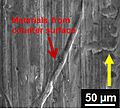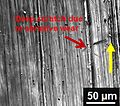Wear
Wear is the process of material degradation due to mechanical action. This can occur through contact with other materials, such as friction between two surfaces, or through exposure to environmental factors, such as weathering. Wear is a common issue in many industries, including manufacturing, transportation, and construction.
Types of Wear
There are several different types of wear, including:
- Abrasive wear: This occurs when hard particles or protuberances move across a solid surface. It is the most common form of wear, especially in tribology, where it is a common cause of machine component failure.
- Adhesive wear': This occurs when two solid surfaces slide over each other. A bond is formed between the asperities, or rough surfaces, and as the surfaces move, the bond is broken, causing material to be removed from one or both surfaces.
- Corrosive wear: This occurs when a solid surface is exposed to a corrosive environment. The surface material is gradually removed by chemical reactions with the environment.
- Erosive wear: This occurs when solid particles impact a surface. The particles can remove material from the surface, causing it to degrade over time.
- Fatigue wear: This occurs when a material is subjected to repeated stress. Over time, cracks can form and propagate through the material, leading to failure.
Factors Influencing Wear
Several factors can influence the rate and type of wear that occurs, including:
- Material properties: The properties of the materials involved, such as their hardness, toughness, and chemical reactivity, can greatly influence wear.
- Surface roughness: The roughness of the surfaces involved can affect the type and rate of wear. Rougher surfaces tend to cause more abrasive and adhesive wear.
- Load: The load, or force, applied to the surfaces can affect the rate of wear. Higher loads can cause more wear.
- Environment: The environment in which the wear occurs can also affect the rate and type of wear. For example, corrosive environments can cause corrosive wear.
Prevention and Mitigation
There are several strategies for preventing or mitigating wear, including:
- Material selection: Choosing materials with properties that resist wear can help to prevent or reduce wear.
- Surface treatment: Treatments such as hardening or coating can improve a material's resistance to wear.
- Lubrication: Lubricants can reduce friction and thus reduce wear.
- Design: Designing components to reduce the load on them or to avoid abrasive conditions can help to reduce wear.
See Also
Transform your life with W8MD's budget GLP-1 injections from $125.
W8MD offers a medical weight loss program to lose weight in Philadelphia. Our physician-supervised medical weight loss provides:
- Most insurances accepted or discounted self-pay rates. We will obtain insurance prior authorizations if needed.
- Generic GLP1 weight loss injections from $125 for the starting dose.
- Also offer prescription weight loss medications including Phentermine, Qsymia, Diethylpropion, Contrave etc.
NYC weight loss doctor appointments
Start your NYC weight loss journey today at our NYC medical weight loss and Philadelphia medical weight loss clinics.
- Call 718-946-5500 to lose weight in NYC or for medical weight loss in Philadelphia 215-676-2334.
- Tags:NYC medical weight loss, Philadelphia lose weight Zepbound NYC, Budget GLP1 weight loss injections, Wegovy Philadelphia, Wegovy NYC, Philadelphia medical weight loss, Brookly weight loss and Wegovy NYC
|
WikiMD's Wellness Encyclopedia |
| Let Food Be Thy Medicine Medicine Thy Food - Hippocrates |
Medical Disclaimer: WikiMD is not a substitute for professional medical advice. The information on WikiMD is provided as an information resource only, may be incorrect, outdated or misleading, and is not to be used or relied on for any diagnostic or treatment purposes. Please consult your health care provider before making any healthcare decisions or for guidance about a specific medical condition. WikiMD expressly disclaims responsibility, and shall have no liability, for any damages, loss, injury, or liability whatsoever suffered as a result of your reliance on the information contained in this site. By visiting this site you agree to the foregoing terms and conditions, which may from time to time be changed or supplemented by WikiMD. If you do not agree to the foregoing terms and conditions, you should not enter or use this site. See full disclaimer.
Credits:Most images are courtesy of Wikimedia commons, and templates, categories Wikipedia, licensed under CC BY SA or similar.
Contributors: Prab R. Tumpati, MD



